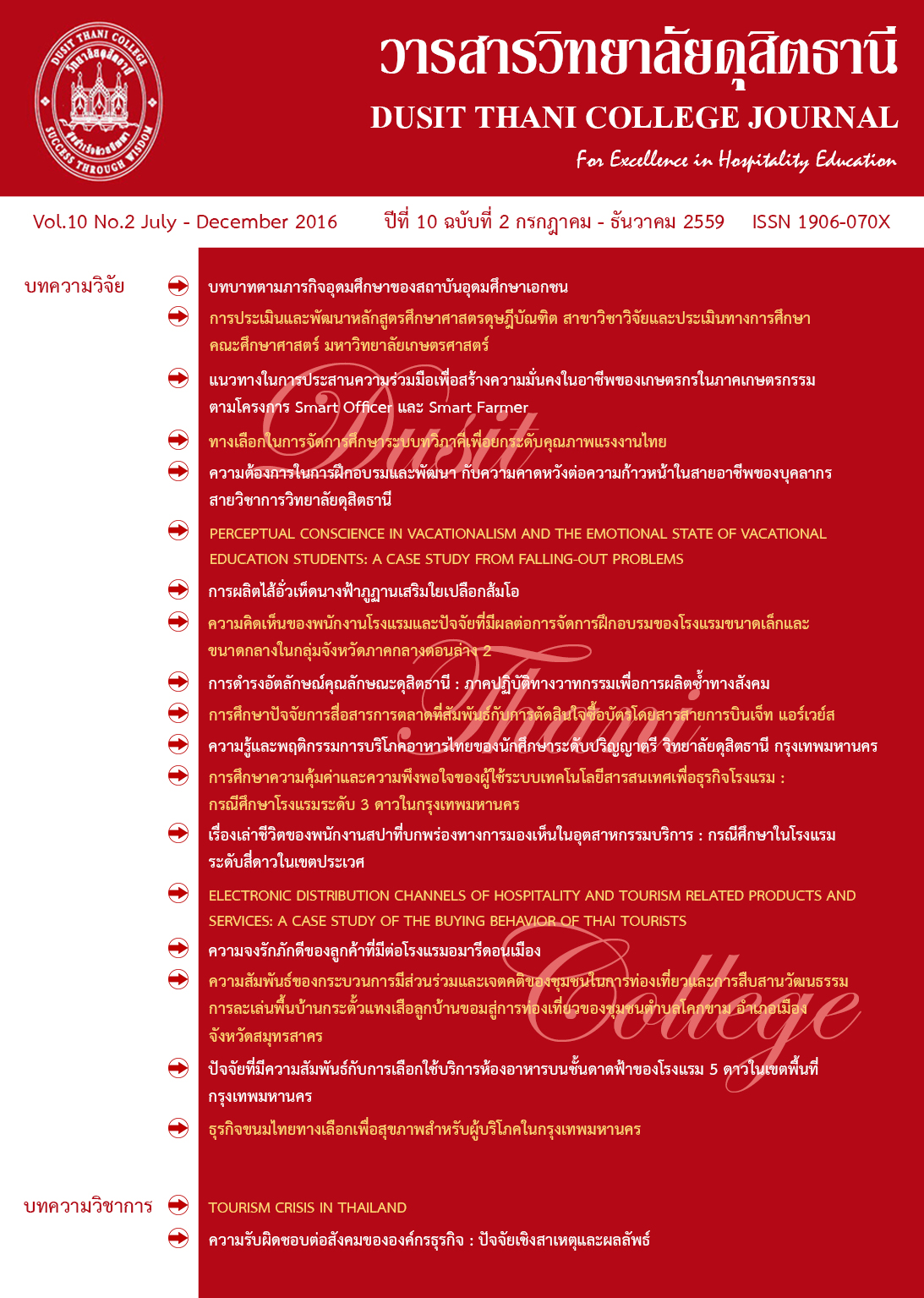THE EXISTENCE OF IDENTITY OF DUSIT CHARACTERS: DISCOURSE PRACTICE TO SOCIAL REPRODUCTION
Main Article Content
Abstract
Identities of education is reflected in the quality of graduates. Education must give priority to exist their identity as determined by education. Dusit Thani College determined DUSIT Characters was the identity of institution. This research aims to study the creation of discourse in the identity of Dusit Thani College; The reproduction of social practices in the discourse; and social practices of discourse in the identity of Dusit Thani College. The key informants consisted of administrators, instructors, students of Dusit Thani College and executive of enterprises that student internship of 58 people and used qualitative approach to conducted in-depth and group interview. The results showed that DUSIT Characters included 1) D: Discipline 2) U: Understanding 3) S: Socialize 4) I: Intellectual and 5) T: Tolerance. Identity of Dusit Thani College is caused by smart, great and happy. Administrators and instructors are focus on creating a discourse on the identity of Dusit Thani College has continued. They promoted through documents, media, activities in college and activities in the subjects. Identity of Dusit Thani College are the core that matches the quality of graduates to meet the needs of enterprises in Thailand and ASEAN.
Article Details
Article Screening Policy
- All research and academic articles to be published must be considered and screened by three peer reviews in the relevant field / article.
- All articles, texts, illustrations and tables published in the journal are the personal opinions of the authors. Editors don't always have to agree. And no responsibility whatsoever is the sole responsibility of the author.
- The articles to be published must never be published. Where did you first publish? And not in the consideration of other journals If the audit found that there has been a duplicate publication It is the sole responsibility of the author.
- Any article that the reader sees as being plagiarized or impersonated without reference. Or mislead the work of the author Please let the journal editor know it will be your greatest blessing.
References
จรรยา แก้วใจบุญ และ นิภา ไชยรินคำ. (2551). อัตลักษณ์ของวิทยาลัยพยาบาล บรมราชชนนี พะเยา. รายงานการวิจัย วิทยาลัยพยาบาล บรมราชชนนี พะเยา.
ฉัตรทิพย์ สุวรรณชิน และพนมพร จันทรปัญญา. (2015). การสร้างอัตลักษณ์ของผู้เรียนในระดับอุดมศึกษา. Panyapiwat Journal. Vol.7 No.2 May-August 2015, 267-280.
ไชยรัตน์ เจริญสินโอฬาร. (2542). วาทกรรมการพัฒนา: ความรู้ ความจริง เอกลักษณ์ และความเป็นอื่น. กรุงเทพฯ: ศูนย์วิจัยและผลิตตำรามหาวิทยาลัยเกริก.
ไชยรัตน์ เจริญสินโอฬาร. (2543). วาทกรรมการพัฒนา: อำนาจ ความรู้ ความจริง เอกลักษณ์ และความ เป็นอื่น. กรุงเทพฯ: สำนักพิมพ์วิภาษา.
ธนสาร บัลลังก์ปัทมา. (ม.ป.ป.). อัตลักษณ์สถานศึกษา. (ออนไลน์). เข้าถึงได้จาก https://www.gotoknow. org/posts/422459 วันที่เข้าถึง : 27 มีนาคม 2558.
ปภาวรินท์ นักธรรมา. (2553). การพัฒนาอัตลักษณ์ของนักศึกษาสาขาการตลาด กรณีศึกษา :
ห้อง MK201 คณะบริหารธุรกิจ โรงเรียนพายัพเทคโนโลยีและบริหารธุรกิจ. รายงานการวิจัยโรงเรียนพายัพ เทคโนโลยีและบริหารธุรกิจ.
พนารัช ปรีดากรณ์ และนเรศน์ วงษ์สุวรรณ. (2552). เศรษฐกิจพอเพียง : การเปิดพื้นที่โดยการวิเคราะห์วาทกรรม. วารสารวิชาการมหาวิทยาลัยหอการค้าไทย. ปีที่ 29 ฉบับที่ 3 เดือนกรกฎาคม-กันยายน 2552.
ราชบัณฑิตยสถาน. (2542). ความหมายของอัตลักษณ์. (ออนไลน์). เข้าถึงได้จาก http://www.royin. go.th/th/knowledge/detail.php?ID=1583 วันที่เข้าถึง : 20 กุมภาพันธ์ 2558.
วิทยาลัยดุสิตธานี. (ม.ป.ป.). เกี่ยวกับวิทยาลัยดุสิตธานี. (ออนไลน์). เข้าถึงได้จาก http://www.dtc.ac.th/th/7-about-dusit-thani-college.html วันที่เข้าถึง 14 กุมภาพันธ์ 2558.
แผนกวิชาการ ฝ่ายวิชาการ วิทยาลัยดุสิตธานี. (2558). คู่มือการศึกษาระดับปริญญาตรี วิทยาลัยดุสิตธานี
ปีการศึกษา 2558. กรุงเทพฯ: วิทยาลัยดุสิตธานี.
ศุภฤกษ์ รักชาติ และ สุวิมล ว่องวาณิช. (2012). การวิเคราะห์ความต้องการจำเป็นด้านความเข้าใจ เกี่ยวกับอัตลักษณ์โรงเรียน และแนวทางการกําหนดอัตลักษณ์โรงเรียนของผู้บริหารสถานศึกษา. วารสารอิเล็กทรอนิกส์ทางการศึกษา. 7(1), 2271-2285.
สุจรรยา โชติช่วง. (2554). การศึกษาสภาพการพัฒนาอัตลักษณ์และเอกลักษณ์ของสถานศึกษา สังกัด สำนักงานเขตพื้นที่การศึกษาประถมศึกษาพิษณุโลก เขต 1. การศึกษาค้นคว้าด้วยตนเอง กศ.ม. สาขาวิชาการบริหารการศึกษา มหาวิทยาลัยนเรศวร.
สุชีพ กรรณสูต. (2552). แนวคิดอัตลักษณ์. (ออนไลน์). เข้าถึงได้จาก http://sucheeppost.blogspot.com/ 2009/05/identity.html วันที่เข้าถึง : 27 กุมภาพันธ์ 2558.
สุพักตร์ พิบูลย์. (2553). 07. อัตลักษณ์ของสถานศึกษาคืออะไร จำเป็นอย่างไร. (ออนไลน์). เข้าถึงได้จาก http://drsuphakedqa.blogspot.com/2010/07/07.html วันที่เข้าถึง : 27 มีนาคม 2558.
สำนักงานรับรองมาตรฐานและประเมินคุณภาพการศึกษา. (2554). คู่มือการประเมินคุณภาพภายนอกรอบ สาม (พ.ศ. 2554-2558) ระดับอุดมศึกษา ฉบับสถานศึกษา (แก้ไขเพิ่มเติม พฤศจิกายน 2554). สมุทรปราการ : บริษัท ออฟเซ็ท พลัส จำกัด.
Alvesson M., and Empson L. (2008). The Construction of Organization Identity comparative case studies of consulting firm. Scandinavian Journal of Management. 24(1), 1-16.
Cornelissen J. P., Haslam S. A., and Balmer J. M. T. (2007). Social Identity, Organizational Identity and Corporate Identity: Towards an Integrated Understanding of Processes, Patterning and Products. British Journal of Management, 18, S1-S16
Fairclough, N. (1995). Media Discourse. London: Edward Arnold.
Fairclough, N. (2010). Critical Discourse Analysis: The Critical Study of language. 2nd ed. New York: Longman.
Foucault, M. (1991). Discipline and Punish: The Birth of The Prison. (Sheridan, Alan Trans). New York: Penguin Books. (Originally published in 1963).
Foucault, M. (2010). The Archaeology of Knowledge: and the Discourse of Language. (Smith, A.M. Sheridan Trans). New York: Vintage Books. (Originally published in 1969).
Patton, M. Q. (1990). Qualitative Evaluation and Research Methods. (2nd Ed.). Newbury Park, CA: Sage Publications, Inc.
Stets, J., E. and Burke, P., J. (2000). Identity theory and social identity theory. Social Psychology Quarterly 2000. 63(3), 224-237.
Stryker, S. (1968). Identity Salience and Role Performance. Journal of Marriage and family, 4, 558-64.
Van Dijk, T.A. (1997). Discourse as Structure and Process. London, Thousand Oaks and New Delhi: SAGE Publications.


